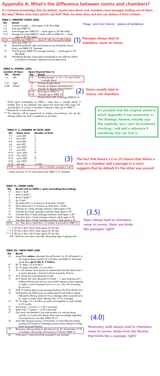>>96424683
>>96424731
>>96424756
Replying here as promised.
>what is the difference between a room and a chamber?
See the attached infographic.
>And my other question is regarding the checks for generating secret doors and one-way doors. How exactly does the procedure work
What's unclear about it?
>how do one-way doors behave?
From one side they look like normal doors and they open normally. From the opposite side they are undetectable and can't be opened. They close on their own some time after the party have passed through.
>If players look for secret passages and doors is there a chance that they appear then after rolling a die or should they've been mapped and rolled for by me in advance?
If you're playing as a DM, secretly determine whether a secret passage or door is there. Remember that secret doors are found with two passes: A first quick check, at one (one-minute) round per 10'×10' sections reveals the presence and location of the door, a second check, at one turn per 10'×10' area, reveals the means to open. DMG 96/97.
If you're playing solo the rule is a bit silly, but basically it's a combined check of being present and being found: If it's there you find it, if you don't find it it isn't there. Of course you can house rule this ("discretion must prevail").
>how do you determine whether an exit is a door or not
Room = door (unless stated otherwise)
Chamber = passage (unless stated otherwise)
>does the entry count towards Table V. C.: Number of exits?
This is obvious from the fact that the table can generate zero exits. So no, it doesn't count.
>how do you treat the doors in your dungeons generally? Are they all stuck and some even locked?
DMG page 97 lists three or four door types. I've created a random table out of it, but regular stuck doors are the default.
